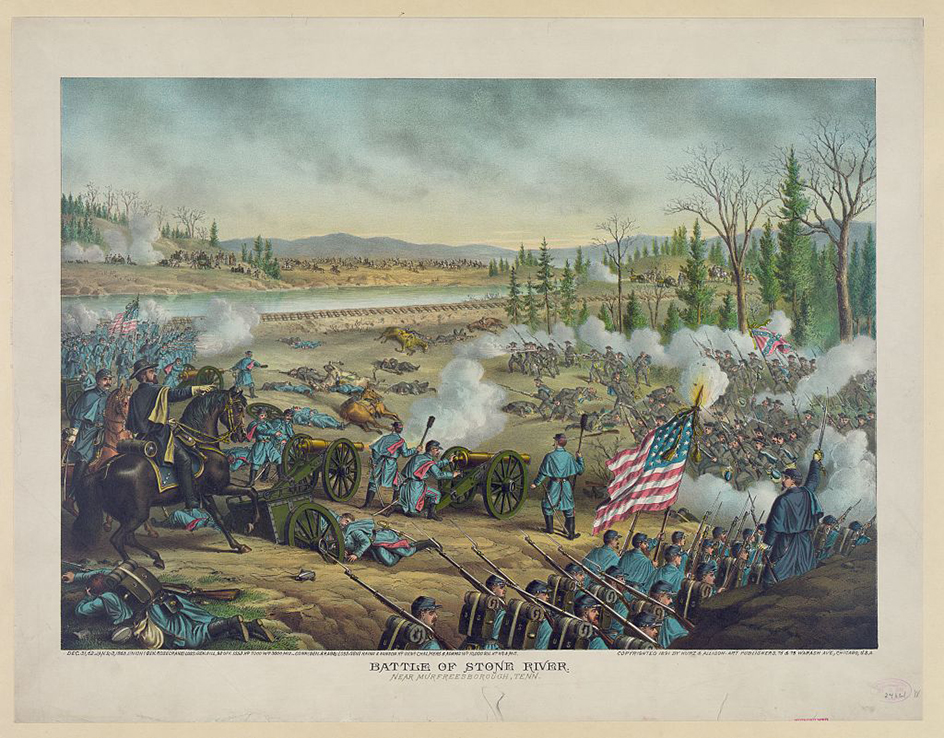Stones River, Battle of, was a hard-fought battle of the American Civil War (1861-1865). The battle, named after a river on the battlefield, was fought in central Tennessee from Dec. 31, 1862, to Jan. 2, 1863. It is also called the Battle of Murfreesboro, after a nearby town. Confederate troops led by General Braxton Bragg failed to follow up on their initial success against Union troops led by General William S. Rosecrans, and the Confederates eventually retreated from the battlefield. The Battle of Stones River had the highest casualty rate of any battle during the war.


On Oct. 8, 1862, Union forces under General Don Carlos Buell fought Confederate troops led by General Bragg at the Battle of Perryville, Kentucky. After the battle, Bragg retreated from Kentucky and eventually camped his army of 37,000 at Murfreesboro.
Despite repeated urgings from Washington, D.C., Buell did not pursue Bragg. In late October, President Abraham Lincoln, who felt that Buell was too cautious, replaced Buell with General Rosecrans. Rosecrans brought his troops together and reorganized them at Nashville, about 30 miles (50 kilometers) northwest of Murfreesboro.
Rosecrans, like Buell, was repeatedly urged to attack Bragg. On December 26, he finally left Nashville with about 45,000 men and headed for Murfreesboro. Due to bad weather and interference from Confederate cavalry, the Union troops did not arrive at the outskirts of Murfreesboro until December 30. When Rosecrans arrived, Bragg’s army was north of Murfreesboro, with most of his men positioned west of the Stones River. Additional Confederate troops commanded by General John C. Breckinridge, the former vice president of the United States, were positioned east of the river.
About dawn on December 31, Bragg’s army attacked the Union troops on the extreme western end of the battlefield and pushed them back toward the Stones River. That afternoon, Breckinridge’s men crossed the river and joined Bragg’s attack against the rest of Rosecrans’s troops. At a place known as the Round Forest, but later called “Hell’s Half Acre,” Confederate troops made a series of uncoordinated frontal attacks. Union troops held their ground and inflicted many casualties.
That night, Bragg telegraphed Richmond, Virginia, the Confederate capital, and reported that he had won the battle. However, Bragg’s claim of victory proved to be premature.
The two sides fought little the following day. But Rosecrans, anticipating a Confederate attack, ordered General Horatio Van Cleve to occupy a hill east of the Stones River. On January 2, Bragg ordered Breckinridge to attack Van Cleve’s men. Breckinridge disagreed with the order, but he nonetheless charged the hill that afternoon. Breckinridge’s men took the hill, but heavy artillery fire from Union batteries on the other side of the river caused many casualties. The Confederates were forced to retreat from the hill.
The following day, the Confederates retreated south from Murfreesboro to Tullahoma, Tennessee. Rosecrans did not pursue them. Both armies rested until late June, when Rosecrans finally advanced toward Bragg. The two armies would not fight a major battle again until mid-September, when they met at the Battle of Chickamauga, Georgia.
During the Battle of Stones River, the Union suffered about 12,900 casualties, and the Confederates about 11,700. Both sides lost nearly a third of their men, the highest casualty rate of the war. President Lincoln later called the battle “a hard-earned victory, which, had there been a defeat instead, the nation could scarcely have lived over.”
See also Bragg, Braxton ; Breckinridge, John Cabell ; Civil War, American ; Rosecrans, William Starke .
